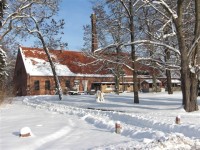3D-Modell, Museumspädagogik, Hoffmannscher Ringofen, Leihgabe Ziegeleipark Mildenberg.
Kontext Sonderausstellung "Zero Carbon. Brandenburgische Industrien im Anthropozän" - Leihgabe
Erbaut einen Ringofen!
Der Erfinder und Unternehmer Friedrich Eduard Hoffmann (1818-1900)
hat diesen praktischen Ofen erfunden. Rund um die Uhr konnte man mit seiner Ringfeuerung Ziegel brennen. Man sparte Energie und Geld. Es dauerte 8-12 Tage, bis die Flamme durch die 10-16 Kammern gewandert war.
Meistens wurden die Ziegel gut. Manchmal waren sie aber krumm und schief, weil die Feuerung schlecht war. Diese Fehlbrand-Ziegel hat man einfach in die Landschaft geschüttet. Die Zeit, in der wir Menschen die Landschaft, das Wasser und die Luft stark verändern, nennen wir Menschenzeit oder „Anthropozän“.
3D-Puzzle eines Hoffmannschen Ringofens, Leihgabe Ziegeleipark Mildenberg
Mauerziegel und Fehlbrandziegel, Leihgabe Ziegeleipark Mildenberg
en

